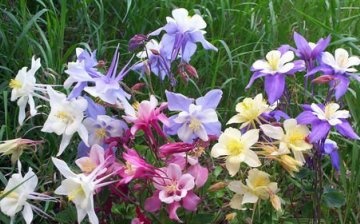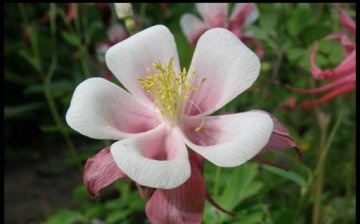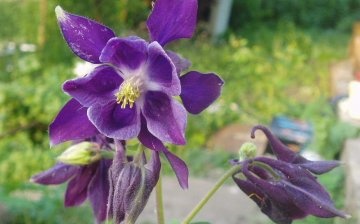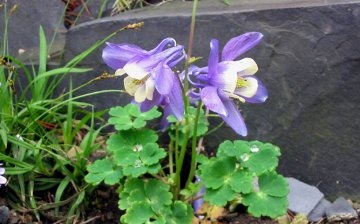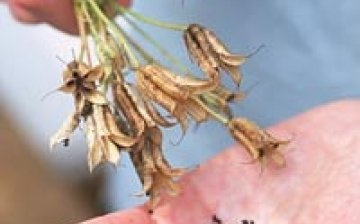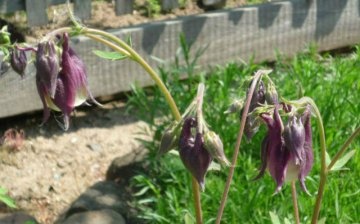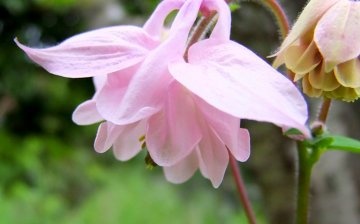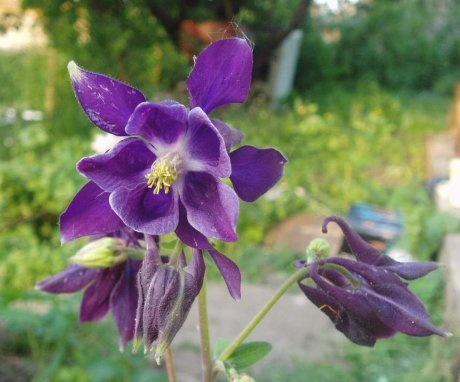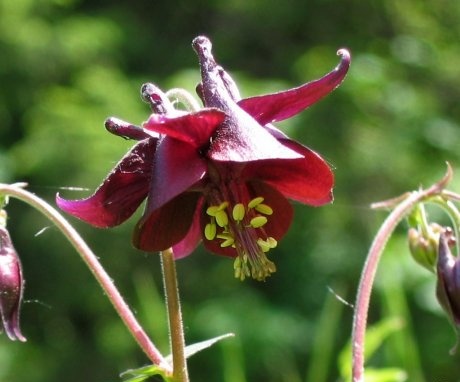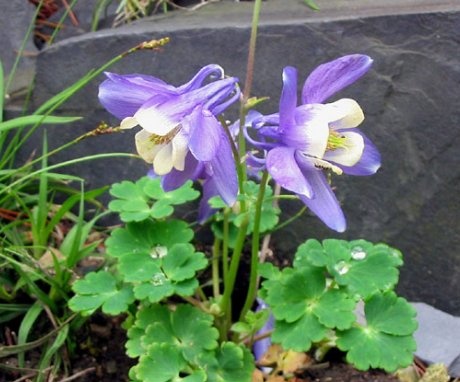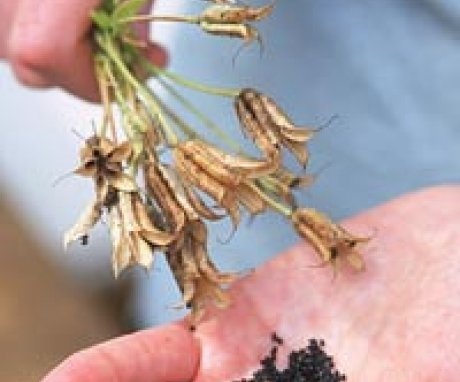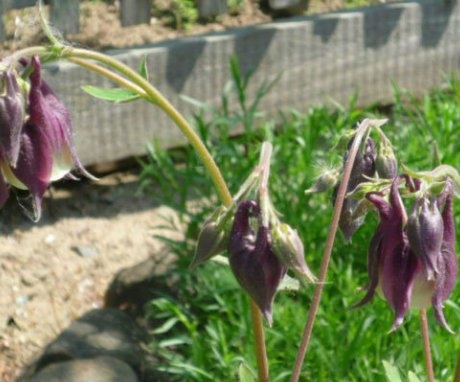Catchment: description, cultivation, reproduction, diseases and useful properties of the plant
The catchment area is spread all over the world, for a person it has long been not only familiar, but even symbolic. Aquilegia is loved by flower growers, and also found a "rightful" place in city parks and gardens around the world.
Content:
- Some interesting information about the catchment
- Description of the plant
- Varieties of this beautiful plant
- Cultivation of the catchment
- Reproduction of the catchment
- Diseases and pests of the catchment
- The catchment from the point of view of medicine
Some interesting information about the catchment
This flower is known even by those who have never been either a florist, or the owner of a land plot, or just a person who crossed the line of the city.
It is to this flower that popular tableware items owe their shape - the so-called bowls, which are also called cocktail bowls.
We are talking about catchment or catchments, whose name in Russian is a literal translation from the Latin word formation aquilegia (from "water" and "collect").
And if in Latin it is Aquilegia, then among the people this flower has a lot of nicknames associated with its appearance - eagle, spur, bell, boots and even doves.
Many interesting and even mystical facts are associated with this plant, among which we will single out the following:
- In Christianity, it symbolizes the holy spirit, and its petals are holy gifts.
- Among the Nordic peoples, this is the "flower of the elves".
- Since the Middle Ages, it is considered an "amulet" and is endowed with the ability to protect from magic and witchcraft.
- For Americans, this is the Columbine dove, which symbolizes the inconstancy of women (this flower is a symbol of temptation and betrayal in many nations).
- The French call them the flower of the grumpy (and therefore the bat) woman (according to legend, only when the woman began to take a decoction of this flower into her mouth, the feuds in the family stopped).
- For the Norwegians, this is the symbol of Freya (goddess of love and beauty).
- For the resemblance of a flower spur to a jester's cap, many peoples have a symbol of stupidity.
- The blue catchment is the symbol of the American state of Colorado.
Aquilegia is widespread throughout the Northern Hemisphere of our planet.
Description of the plant
The catchment is a perennial herb from the buttercup family.
Due to its wide distribution, aquilegia has more than a hundred described species in their natural environment, but people do not grow most of them.
Distinctive external feature of the catchment area:
- Flowers of a specific shape and different colors, which are connected to the stem with a kind of "spur" or "spur", as it is commonly called among flower growers. As a rule, the catchment has aesthetic double-triple trifoliate leaves, which have a bluish tinge.
- Sizes of leaves in centimeters: length about 5, width up to 3. The leaves have a water-repellent surface, so the plant "cries" with drops of dew or rain (the function of collecting water was usurped by the buds).
- The flower bud consists of five petals, which are separated and form a kind of funnel, which has a "spur" at the end, as well as five cupped leaves.
- At the root, the leaves turn into a rosette, which will develop into a stem after spring.
- Its size is dictated by the variety and type of aquilegia, in centimeters from 20 to 100.
- With the growth of the plant, the stem grows overgrown with its leaves and peduncles: these are inflorescences of 8-12 pieces or "solo" flowers.
The flowering period of the catchment area begins in most cases with the arrival of summer.
A single flower blooms for about a week, and the full flowering time of a culture lasts about a month. Aquilegia has a well-developed root system - the root is thick at the base and penetrates into the soil to a considerable depth.
The catchment has a pod-shaped fruit with small black seeds that are easily carried by the wind when the fruit is ripe and open.
Varieties of this beautiful plant
The catchment, both in nature and in floriculture, is an extremely diverse plant.
There are many types and varieties of it, if we talking about cultivation.
Without pretending to be comprehensive, we will give only some assortment:
- Along the length of the stem, the aquilegia is short, medium-sized and tall.
- By the type of flower, there are double, non-double and semi-double.
Most widespread:
- The common catchment is a non-selective species taken in its natural form from nature, usually the height is 40-80 centimeters, the colors are different, the spur is short.
- The catchment is blue, native to North America, reaches a height of up to 70 centimeters, a bush about half a meter in diameter with flowers that have blue or lilac leaves and white petals, as well as a long spur
- The catchment is Olympic, the flowers are blue-white, large and showy, the stems are 30-60 centimeters high with fluffy peduncles.
- The catchment is two-colored with a height of no more than 15 centimeters, like all undersized aquilegia, it is fragile and delicate, originally from the Pyrenees, has a light blue bud and a cream-colored cup.
- The catchment of Bertoloni is also undersized, the flowers are large, blue and bloom in the second half of spring.
- The catchment of Yekalkarat, another undersized (up to 20 centimeters), but sporeless, has cherry-colored flowers.
- The catchment is fan-shaped, a low-growing Far Eastern species, 20-30 centimeters high, has large white, lilac-blue or purple flowers with a long hook-like spur.
- The catchment is Canadian, a medium-sized plant (up to 60 cm), has reddish leaves, yellow petals, and a brown-red spur, very resistant to cold, and begins to bloom in late spring.
- The catchment is ferruginous, it is medium-sized, lilac-blue, with the fluff of the same name.
- The catchment is alpine, 30 centimeters high, large flowers in blue, blue and purple tones, blooms in mid-summer.
- The catchment is dark, medium-sized aquilegia, large flowers with rich purple-blue-purple flowers.
- The most common culture in gardens, parks and squares is the hybrid catchment. There are a huge number of bred varieties of this aquilegia, but usually it is 50-100 centimeters high, the flowers are large, both simple and double, one-color and two-color, and the color range is incredibly diverse and variegated - white, pink, yellow, lemon, lilac , blue and even red.
Cultivation of the catchment
Aquilegia is an unpretentious plant, but it will respond a hundredfold to an attentive attitude towards itself and will be able to express itself as much as possible in all its glory.
Any soil is suitable for the catchment area, preferably loose and moderately moist, and certainly not heavy loamy soils.
The plant is not afraid of the direct sun, but it is preferable not to allow this - then the flowering will take longer and more abundant, and the flowers will be larger. So, aquilegia will calmly grow with you even in the shade of trees, literally at their roots. However, a measure is also needed here - if there is complete "darkness" - expect many diseases.
You need to plant a catchment:
- To a depth of at least 20 centimeters, a nutritious loose mixture will be very useful.
- Then it is necessary to prevent compaction and "waterlogging" of the soil.
- Bushes need to be planted at least: 20 cm - for undersized, and 40 cm - for ordinary ones.
- In addition to the amount of growth, one should also take into account the amount of light on the site (the less it is, the less often planting) and ventilation (affects the pathogenicity, therefore, it should be sufficient).
- Care should be taken that the land is loose and weeded from unnecessary weedy neighborhood.
- Since this perennial tends to "expand" in the spring due to the compaction of the root and stem, it is recommended to sprinkle the hole on top with compost or humus (annually).
- The catchment naturally loves moisture, so you should take care of moisturizing the site and in your garden.
However, he is not afraid of drought, since the root system of aquilegia is well developed enough to extract water from the depths of the earth. However, this will affect the "power" of the plant - it will not be able to fully manifest all its beauty during flowering.
Aquilegia is also undemanding in terms of fertilizing with fertilizers - it is enough for it to initially apply complex fertilizers, and then after it has faded. In principle, this perennial plant will "ask" itself - this is noticeable in appearance (a decrease in the intensity of flowering and a riot of colors).
At the end of the flowering time, it is recommended to cut the shoots of the catchment area to a kind of rosette of basal leaves at the base of the stem.
If you want to get seeds for propagation, then this must be done before the fruits crumble (as soon as they turn brown) and scatter themselves.
Reproduction of the catchment
The catchment has two types of reproduction - by seeds or vegetative.
It is noticed that when aquilegia is cultivated in one place for more than 6 years, this plant grows old, its qualities deteriorate (frost resistance is lost, flowers become smaller, and diseases are more frequent). But due to the ability of the plant to self-seeding, the flower bed does not lose its decorativeness, as new young bushes are constantly growing.
If the care of the plant is minimized, this is fraught with the fact that there is a cross-pollination of varieties and the "breed" gradually degenerates in the direction of simplifying its characteristics:
- In connection with this feature, for the breeding of the variety, it is recommended to grow the varieties separately and "protect" using artificial pollination.
- Seeds of the catchment area are not capable of long "waiting" (germination decreases over time), so they are sown in "winter" or stratified if they are sown in the spring.
- The first flowering is observed in the second year, and wait for the lush color of the seedlings a year later. A characteristic feature is that it is young plants that tolerate transplantation.
- Vegetation is more common to preserve the purity of a particular variety - through dividing the bushes or grafting with a shoot growing at the root.
- It must be borne in mind that in this regard, the catchment, like all buttercups, is not a gift and you will have to tinker with it. This is due to the specific tissue-conducting structure of this plant family.
- Get ready for the fact that adult bushes will not take root well, since it is almost impossible to dig up a long aquilegia root without damage.
For reproduction by dividing the bush, it is customary to use a three-year-old catchment.
The dug root is washed, divided along so that the necessary divided parts have root and kidney processes. After that, the resulting "embryos" with the wounded side sprinkled with charcoal are planted in loose soil. This should be done in the spring and no later than autumn, so that the seedlings have time to take root and prepare for wintering.
Cutting aquilegia is even easier - in the spring they break off the young shoot of the plant, process it with a rooting agent and plant it in loose soil or just sand in a greenhouse, and then only shade and systematic moistening.
Diseases and pests of the catchment
Aquilegia flowers are healthy and do not get sick often - mainly due to abnormal humidity.
These diseases are most common in watersheds:
- Powdery mildew, causing them a white coating in damp cold weather. In this case, it is recommended to treat the plant with preparations that contain copper. It should be treated as early as possible, and then the procedure should be repeated for several weeks.
- All others garden diseases (rot, spotting, mosaic) - are fatal in most cases for this plant.
Pests almost do not pay attention to aquilegia due to its natural toxicity (only occasionally damage from caterpillars and aphids can occur). But the defeat by different viruses are the same as in other plants... In such a situation, the struggle is useless and the plants must be pulled out and burned.
The catchment from the point of view of medicine
Although the catchment is used in folk medicine all over the world, drugs based on them should in no case be used without professional advice, since this plant is extremely poisonous, and especially the seeds.
Symptoms of poisoning are poor health, weakness, convulsions, and in a lethal case, respiratory arrest (drinking plenty of fluids with gastric lavage is first aid).
Therefore, if you have such poisonous plants on your site, try to warn, first of all, children about such a danger.
But aquilegia poisoning is an out of the ordinary case, in general, it is a very useful ornamental plant:
- Watersheds are commonly used for design - both landscape and mixed plantings in garden plots.
- It is best to combine this plant with others in such a way that it is ahead of others and does not get lost behind anyone's "back", and every flower can be seen without any difficulty.
Depending on the variety, the catchment goes well with other horticultural crops:
- Stunted with the same small plants, for example, cloves.
- High - in combination with perennials such as bells or poppies.
- Near reservoirs, the catchment area can form simply delightful compositions with ferns, irises, Astilboy and Leotards.
- Even aquilegia itself, when grown in different varieties, looks very good and at the same time you can choose such a flowering period for each variety that the whole season of the flower bed will "bloom and smell".
- Small varieties are also suitable for cultivation as pot plants.
The catchment does not lose its color brightness when dried, therefore it is used by masters who create paintings and panels from dried plant material.
Summarizing the above, it must be said that people have been growing this flower, beloved by them for its unpretentiousness and gracefulness of beauty, for the fourth century. And he responds with kindness - almost without care, for many years, it grows and blooms in the same place, both in the sun and in the shade, without a special shelter for the winter, without being picky about the soil.
More information can be found in the video.



